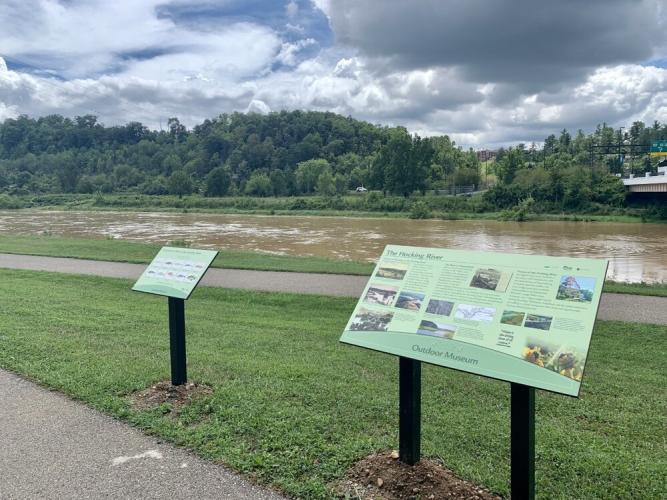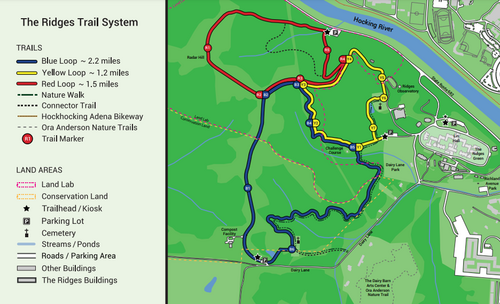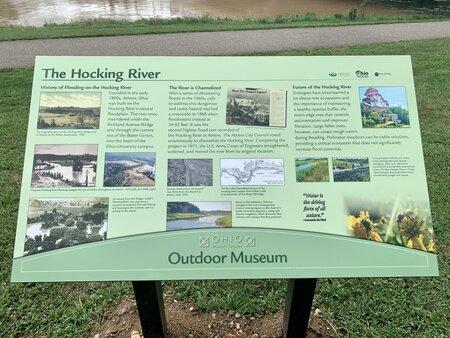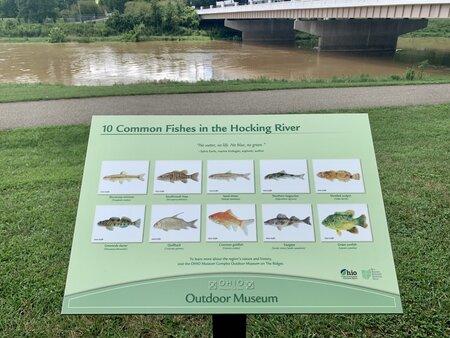

Three recent Ohio University alumni leveraged their graduate research to expand outdoor immersive learning at the OHIO Museum Complex (OMC) by helping to develop signage in the Outdoor Museum .
Emily Feist graduated in May 2021 with a master’s degree in Outdoor Recreation and Education and a certificate in Museum Studies; Jasmine Facun graduated in May 2020 with a master’s degree in Environmental Studies; and Moira Snuffer graduated in May 2020 with a master’s degree in Environmental Studies. Each of these students contributed unique skills gained through their graduate training at OHIO to share knowledge with the general public as a tangible outcome of their studies.
Feist helped develop outdoor learning experiences and wayfinding signage for the Outdoor Museum, in addition to developing a trail map with three hiking loops. She also produced a nature journal and a folding trail map.
“ Outdoor recreation and education is a growing field that explores how people take part in outdoor activities to enhance wellbeing and engage in informal learning experiences,” Feist said. “The Outdoor Museum celebrates the rich history of our place, connecting nature and the environment with health and wellness opportunities. It's an important resource, welcoming a diverse community of all ages and backgrounds to find something they can enjoy, learn something new from, and have a break from the day to day.”
To develop the wayfinding signs, Feist thought through how visitors utilize and interact with information in a spatial context. She worked with outdoor experts to shape a series of interconnecting trails into three main loops that depart from different parking areas and considered how the absence of clear navigational signage can limit a person’s desire to engage in the outdoor learning. She challenged herself to design a system to help overcome those obstacles.
“I enjoyed thinking through the user experience for an array of activities from running to research, recreation to education, in a way that welcomes new and repeat visitors to the space,” Feist said. “Principles of outdoor recreation and graphic design were critical in helping me to process the user experience and translate it into a tangible visual language to enhance enjoyment for visitors on The Ridges. It was an honor to be trusted with developing the educational trail map for the OMC, and to use what I learned at Ohio University to improve the campus and community.”
This year, Feist will continue her work with the Outdoor Museum Complex and Crane Hollow Nature Preserve in an AmeriCorps position that will leverage a priceless local natural history collection for exhibitions and educational programming.
Facun’s graduate project focused on the Hocking River, creating a project that explored the effects of mowing regimes on plants and pollinators in the river. She developed a sign about the past, present, and future of the Hocking River, placed near the river and accessible from the Hockhocking Adena bikeway and the Peden Stadium parking lot.
“To me, history and science are a fitting pair, as science works best when the researcher intimately understands the work that's already been done before her,” Facun said. “History not only teaches us where we've been but provides a roadmap for where we might go. In many ways, Athens was shaped by the Hocking River's wildness until one day, through a feat of human engineering, the river was tamed, confining its meandering to a straight channel. Tampering with nature is rarely without consequences though, and in the years since the river's channelization, we've learned volumes about river ecosystems and riparian buffers.”
Facun explained that with some partial restoration of the riparian habitat and considerations to more timely mowing strategies, it may be possible to return this once-wild slice of our town to a productive habitat for pollinators and other wildlife, without jeopardizing flood protection.
“The experience of collaborating on the Outdoor Museum allowed me to stretch some creative muscle and brought together three of my favorite things – art, history, and science,” Facun added. “I was given valuable opportunities to network with folks at the University whom I've respected for a long time, such as Nancy Stevens, Faith Knutsen, and Jen Bowman. The museum signs feel like a tangible extension of my graduate research that I can proudly share with my family and my community. It's really what grad school should be all about – taking what we learn in the classroom and in the field and breathing real-world application into our knowledge.”
Facun now works as the Baileys Trail System program assistant at Rural Action.
Snuffer’s graduate project focused on ecosystem health through collecting and identifying macrovertebrates and invertebrates in the Hocking River. She used this knowledge, together with her artistic skills, to contribute to the Outdoor Museum.
Located near the Hocking River sign, accessible from the bike path and Peden Stadium parking lot, Snuffer’s sign features her original watercolor paintings of 10 common fishes in the Hocking River, as a means of educating visitors about the region’s aquatic inhabitants and how these species reflect ecosystem health.
“The Hocking River greatly impacts people and wildlife throughout the 102 miles it runs within the state, serving as a recreational space for families and providing important practical considerations including drinking water,” Snuffer said.
She adds that the river flows into the Ohio River, so it is a smaller part of a larger system, affecting the health of rivers flowing all the way to the ocean.
“ Contributing to the OMC’s Outdoor Museum has been an outlet to combine my passion for art, education and science,” Snuffer said. “Every species in an ecosystem provides a unique story, and fishes are often overlooked in what they can tell us about ecosystem health and interactions. It was great to have the opportunity to share what I learned in my graduate studies through this compelling platform. Being able to give back to the community that has helped me grow as an artist and scientist is thrilling, and I hope that the educational signs in the Outdoor Museum help excite others living in the area to explore, learn and play in the Hocking River ecosystem.”
Snuffer now works with the Colorado Natural Heritage Program on the National Wetland Condition Assessment Team.
The OHIO Museum Complex offers internship opportunities for students at Ohio University to explore their interests, get to know educators and professionals across disciplines and create meaningful work both inside and outside the classroom setting.
“OMC interns share what they learn in OHIO classrooms, laboratories and studios in novel and exciting ways. These students contribute creatively to society, connecting with ever-broader audiences and leveraging their education to make a tangible impact,” said Stevens, distinguished professor in the Heritage College of Osteopathic Medicine and co-lead of the OMC.
To learn more and/or to contribute to the OMC, please visit the website .




